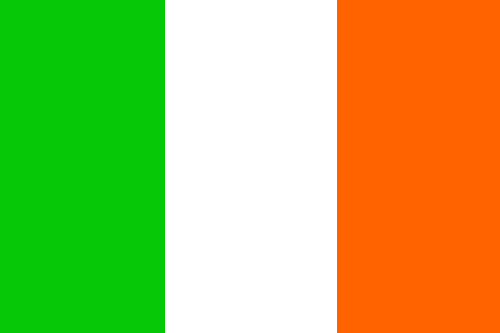Login form
Customs of Ireland
 Marriage and Family
Marriage and Family
People usually marry in their early to mid-20s. Most weddings are performed in a church, but a minority are also performed in a registry office. After marriage, many people in rural areas stay close to their family’s home and visit frequently. Many couples, particularly in the cities, live together before or instead of marriage.
Typically, the bonds between siblings in an Irish family are especially strong. In rural areas, extended families often live near one another, and family members who have moved to
Eating
As an agricultural country,
The traditional cooked breakfast consists of any or all of the following: bacon, sausages, grilled or fried tomatoes, mushrooms, eggs, white and black pudding (a form of blood sausage) and toast or bread fried in fat or oil. Fewer people now eat such a morning meal, however, preferring a lighter breakfast. In recent years, the Irish, particularly those in urban areas, have become much more adventurous in their diet, and now eat a wide variety of European and ethnic food. Pubs (public houses) and cafés serve both snacks and full meals.
The Irish generally eat three meals a day. The midday meal is usually referred to as lunch and the evening meal as dinner or, when it is less formal, as supper. But some rural people call the midday meal dinner and the early-evening meal tea. Many people, particularly in
Socializing
The traditional Irish greeting Céad míle fáilte literally means “A hundred thousand welcomes.” However, the Irish greet one another with common English phrases such as “Hello” and “How are you?” or more casual greetings such as 'How's it going?' The most typical Irish greeting is Dia dhuit, which means “God be with you.” Goodbye is expressed with Slán (roughly “Go safely”) or the warmer Slán agus beannacht ('Go safely, and blessings be with you'). Greetings are generally accompanied by a firm handshake, although in cities and among younger people it is not unusual for women to be kissed on the cheek when greeting. The use of first names is now widespread.
Unless one knows someone well, it is usual to telephone before visiting. Rural people are more likely than urban dwellers to drop in on friends unannounced, as was common practice in the past. People like to meet for conversation in pubs, which are important centers of social life.
Visiting in the home takes place during holidays, especially between Christmas and New Year’s Day, which is also the time when young people living abroad usually come home to visit. Parties are also popular during holidays.
Recreation
The Irish are sports-oriented, and most weekends include some sporting activities for the family or the individual. Popular sports include the two national pastimes: Gaelic football and hurling, both strictly amateur sports. The women’s version of hurling is called camogie. Hurling, a fast and skillful game, is played on a soccer-type field with wooden sticks and a small leather ball. Gaelic football is played with a round ball; its rules are similar to soccer, but players can touch the ball with their hands, although they cannot pick it up from the ground. The ball is punched, not thrown, and it can be kicked. Scoring is done in a soccer-type net, but, as in hurling, points can also be made for going over the top of the goal. Gaelic football is the precursor of Australian Rules football; the two sports are similar enough that Irish and Australian teams sometimes play each other with a set of compromise rules. The All-Ireland semifinals and finals, sponsored by the Gaelic Athletic Association (GAA), are highlights of the hurling and Gaelic football seasons.
Soccer, rugby, sailing, cycling, golf, and horse and greyhound racing are also favorite activities. Soccer has become a particularly popular spectator sport in the 1990s, reflecting the enthusiasm surrounding the national team’s successes during the first half of the decade. Fishing, or angling, is also a common recreational activity, featuring mainly trout and salmon fishing. Rugby internationals played at
Holidays and Celebrations
The Irish celebrate New Year’s Day on 1 January. Saint Patrick’s Day on 17 March is a national holiday and is marked by parades, shamrock decorations, and sometimes the wearing of clothing that is green (the national color). Legend has it that resourceful Saint Patrick made use of the three-lobed shamrock as a diagram to explain the Holy Trinity to his uneducated congregation. However, the pre-Christian Irish had long associated the shamrock with Trefulngid Tre-eochair (“The Triple Bearer of the Triple Key”), the spring fertility god manifestation, whose symbol can be a shamrock or three legs spiraling together (as seen on the flag of the
The Irish celebrate Easter, and Easter Monday is a public holiday. Christmas is celebrated on 25 December, but celebrations may last until New Year's Day. An old custom has boys blackening their faces, carrying paper wrens, and asking for spare change on Saint Stephen’s Day (26 December). This is called “hunting the wren,” and the boys are known as 'wren boys.' This tradition commemorates the old story of how the wily wren tricked the mighty eagle into giving up the title of King of All Birds. This custom is not very common today, particularly outside of rural areas.
“Bank holidays,” days when banks and other businesses close, occur on New Year’s Day, the first Mondays of May, June, and August, and the last Monday in October.
Source: Encarta Interactive World Atlas

